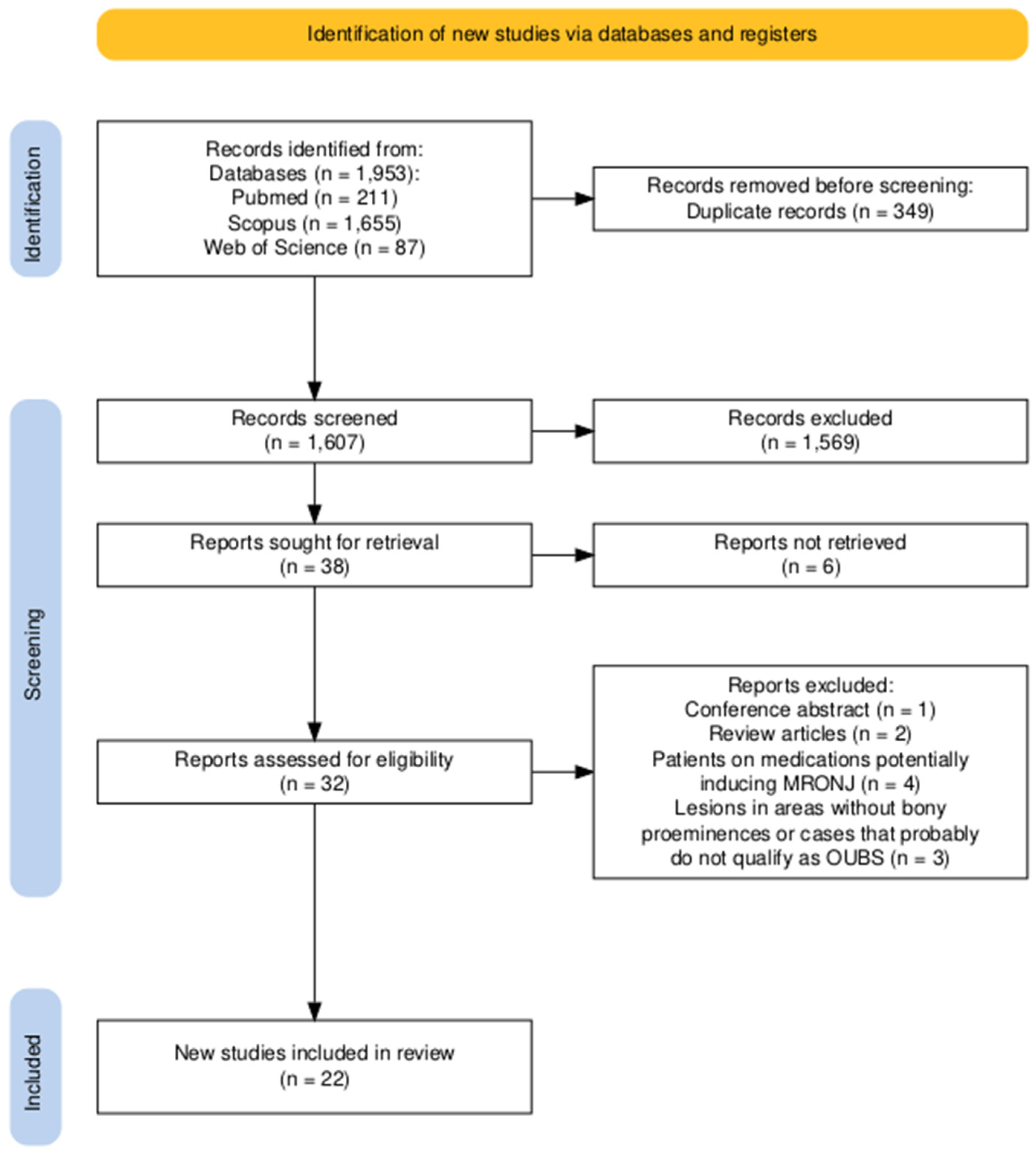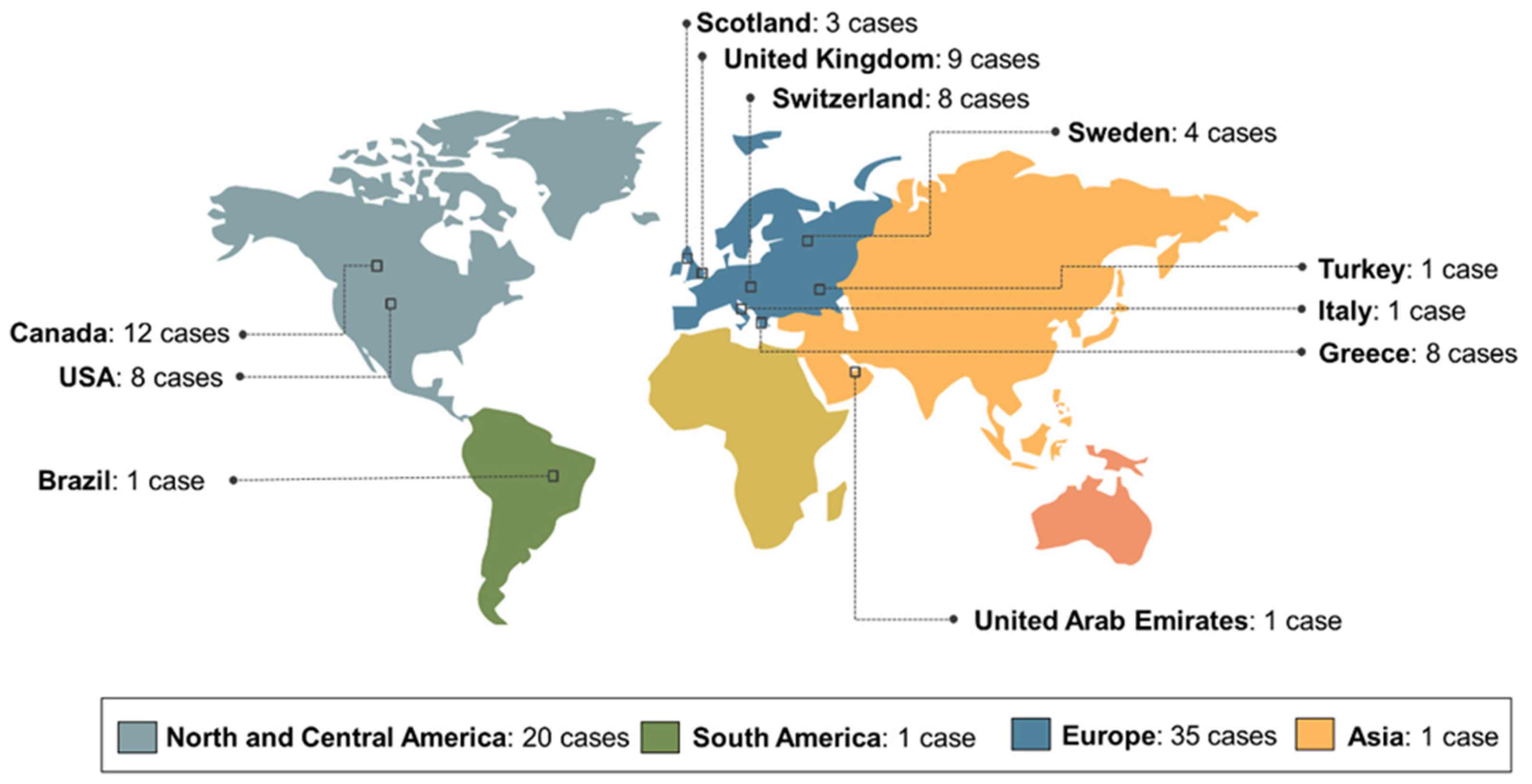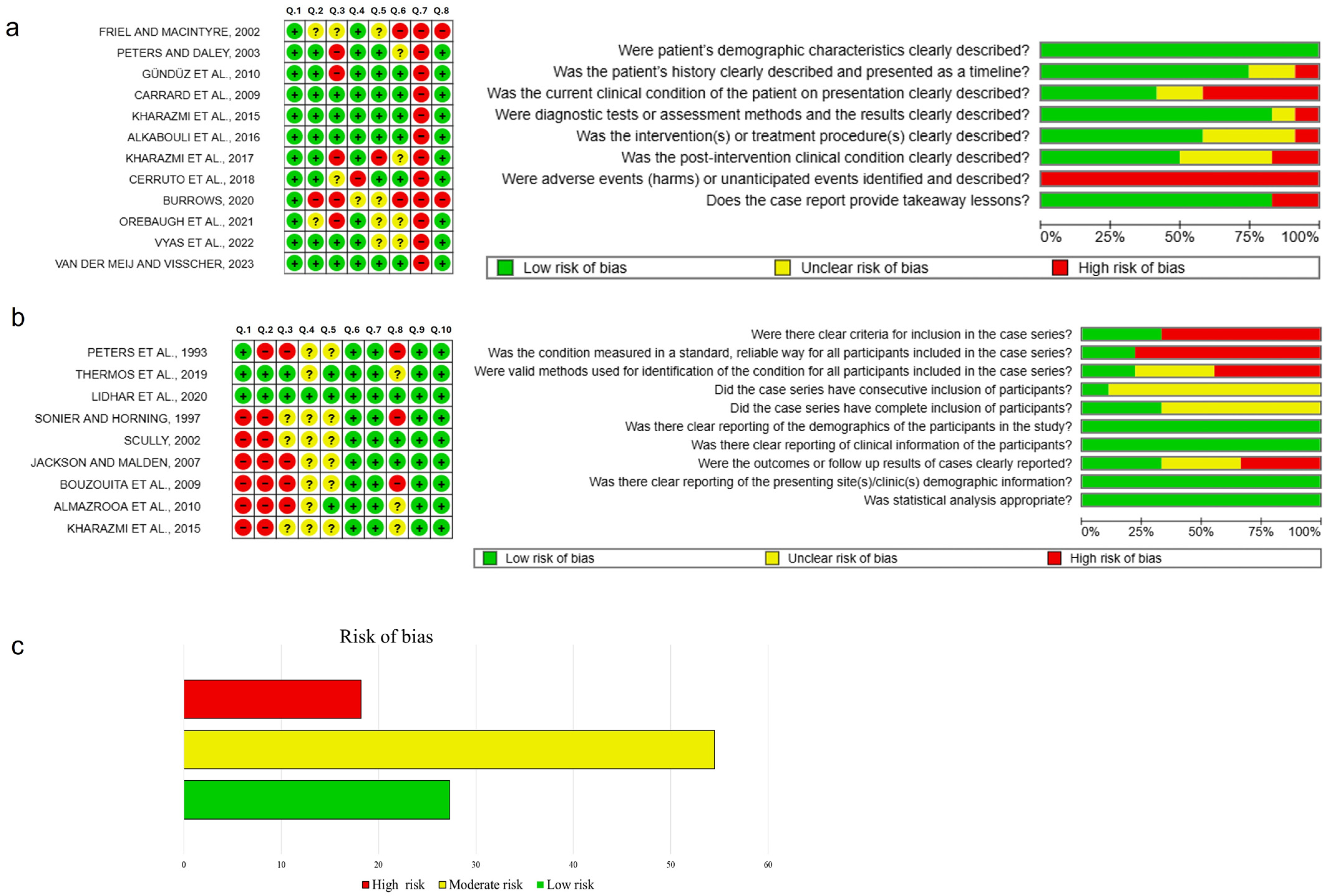Oral Ulceration with Bone Sequestration: Key Insights for Clinicians and Their Relevance in Contemporary Clinical Practice—A Narrative Systematic Review
Abstract
1. Introduction
2. Materials and Methods
2.1. Data Sources and Search Strategies
2.2. Eligibility Criteria and Study Selection
2.3. Data Extraction and Analysis
2.4. Quality Assessment
3. Results
3.1. Study Selection
3.2. Study Characteristics
3.3. Clinical Characteristics
3.4. Quality Assessment
4. Discussion
5. Conclusions
Supplementary Materials
Author Contributions
Funding
Institutional Review Board Statement
Informed Consent Statement
Data Availability Statement
Conflicts of Interest
Abbreviations
| OUBS | Oral ulceration with bone sequestration |
| MRONJ | Medication-Related Osteonecrosis of the Jaw |
References
- Peters, E.; Lovas, G.L.; Wysocki, G.P. Lingual mandibular sequestration and ulceration. Oral Surg. Oral Med. Oral Pathol. 1993, 75, 739–743. [Google Scholar] [CrossRef] [PubMed]
- Thermos, G.; Kalogirou, E.M.; Tosios, K.I.; Sklavounou, A. Oral ulceration with bone sequestration: Retrospective study of eight cases and literature review. Oral Dis. 2019, 25, 515–522. [Google Scholar] [CrossRef] [PubMed]
- Lidhar, T.; Ethunandan, A.; Ethunandan, M. Spontaneous oral ulceration with bone sequestration: Its relevance in current clinical practice. Br. J. Oral Maxillofac. Surg. 2020, 58, e75–e79. [Google Scholar] [CrossRef] [PubMed]
- Friel, P.; Macintyre, D.R. Bone sequestration from lower 3rd molar region. Br. Dent. J. 2002, 193, 366. [Google Scholar]
- Peters, E.; Daley, T. Persistent painful ulcer of the posterior lingual mandibular mucosa. J. Contemp. Dent. Pract. 2003, 4, 71–75. [Google Scholar]
- Carrard, V.C.; Sieck, G.G.; Chaves, A.M.; Filho, M.S.; Rados, P.V. Oral ulceration with bone sequestration: A case report. RFO 2009, 14, 149–152. [Google Scholar]
- Gündüz, K.; Özden, B.; Murat, K.U.R.T.; Bulut, E.; Günhan, Ö. Lingual mandibular bone sequestration. J. Dent. Fac. Atatürk Univ. 2010, 3, 1–4. [Google Scholar]
- Villa, A.; Gohel, A. Oral ulceration with mandibular necrosis. J. Am. Dent. Assoc. 2014, 145, 752–756. [Google Scholar] [CrossRef]
- Kharazmi, M.; Carlsson, A.P.; Hallberg, P. Mandibular Bone Exposure and Osteonecrosis in a Patient With an Uncomplicated Medical History. J Craniofacial Surg. 2015, 26, 1719–1720. [Google Scholar] [CrossRef]
- Alkhabuli, J.; Kokovic, V.; Emad, A. Post extraction lingual mucosal ulceration with bone necrosis. Saudi J. Dent. Res. 2016, 7, 34–37. [Google Scholar] [CrossRef]
- Kharazmi, M.; Nilsson, U.; Hallberg, P. Case report: Osteonecrosis as a complication of GA. Br. Dent. J. 2017, 222, 645. [Google Scholar] [CrossRef] [PubMed]
- Cerruto, C.; Ugolini, A.; Cozzani, M. Lingual mandibular osteonecrosis after dental impressions for orthodontic study models. Am. J. Orthod. Dentofac. Orthop. 2018, 153, 445–448. [Google Scholar] [CrossRef] [PubMed]
- Burrows, R.S. Oral ulceration with bony sequestration. Br. Dent. J. 2020, 228, 397–398. [Google Scholar] [CrossRef] [PubMed]
- Orebaugh, S.L.; Eutsey, R.; Chung, W. Osteonecrosis of Bilateral Mandibular Tori After Direct Laryngoscopy. Anesth. Prog. 2021, 68, 26–28. [Google Scholar] [CrossRef]
- Vyas, R.; Gohel, A.; Escoffier, C.; Shan, K.; Katz, J. Idiopathic lingual mandibular sequestration and its relationship to medication-related osteonecrosis of the jaws (MRONJ): Mini review. Quintessence Int. 2022, 53, 868–873. [Google Scholar] [CrossRef]
- Van der Meij, E.H.; de Visscher, J.G.A.M. Ulceraties van het mondslijmvlies [Ulcerations of the oral mucosa]. Ned. Tijdschr. Tandheelkd. 2023, 130, 243–247. [Google Scholar] [CrossRef]
- Sonnier, K.E.; Horning, G.M. Spontaneous bony exposure: A report of 4 cases of idiopathic exposure and sequestration of alveolar bone. J. Periodontol. 1997, 68, 758–762. [Google Scholar] [CrossRef]
- Scully, C. Oral ulceration: A new and unusual complication. Br. Dent. J. 2002, 192, 139–140. [Google Scholar] [CrossRef]
- Jackson, I.; Maiden, N. Lingual mucosal ulceration with mandibular sequestration. Dent. Update 2007, 34, 573–577. [Google Scholar] [CrossRef]
- Bouzouita, I.; Abi Najm, S.; Lombardi, T.; Samson, J. Séquestration Osseuse sur extrémité distale de lalignemylo-hyoïdienne: À propos de huitcas. Méd. Buccale Chir. Buccale 2009, 15, S17–S23. [Google Scholar] [CrossRef]
- Almazrooa, S.A.; Chen, K.; Nascimben, L.; Woo, S.B.; Treister, N. Case report: Osteonecrosis of the mandible after laryngoscopy and endotracheal tube placement. Anesth. Analg. 2010, 111, 437–441. [Google Scholar] [CrossRef] [PubMed]
- Kharazmi, M.; Björnstad, L.; Hallberg, P.; Wanbro, J.; Carlsson, A.P.; Habib, S.; Warfvinge, G. Mandibular bone exposure and osteonecrosis as a complication of general anaesthesia. Upsala J. Med. Sci. 2015, 120, 215–216. [Google Scholar] [CrossRef] [PubMed]
- Farah, C.S.; Savage, N.W. Oral ulceration with bone sequestration. Aust. Dent. J. 2003, 48, 61–64. [Google Scholar] [CrossRef] [PubMed]
- Palla, B.; Burian, E.; Klecker, J.R.; Fliefel, R.; Otto, S. Systematic review of oral ulceration with bone sequestration. J. Cranio-Maxillofacial Surg. 2016, 44, 257–264. [Google Scholar] [CrossRef]
- Khan, A.A.; Morrison, A.; Hanley, D.A.; Felsenberg, D.; McCauley, L.K.; O’Ryan, F.; Reid, I.R.; Ruggiero, S.L.; Taguchi, A.; Tetradis, S.; et al. Diagnosis and management of osteonecrosis of the jaw: A systematic review and international consensus. J. Bone Miner. Res. 2015, 30, 3–23. [Google Scholar] [CrossRef]
- Khan, A.A.; Morrison, A.; Kendler, D.L.; Rizzoli, R.; Hanley, D.A.; Felsenberg, D.; McCauley, L.K.; O’Ryan, F.; Reid, I.R.; Ruggiero, S.L.; et al. Case-Based Review of Osteonecrosis of the Jaw (ONJ) and Application of the International Recommendations for Management From the International Task Force on ONJ. J. Clin. Densitom. 2017, 20, 8–24. [Google Scholar] [CrossRef]
- Moher, D.; Liberati, A.; Tetzlaff, J.; Altman, D.G. Preferred reporting items for systematic reviews and meta-analyses: The PRISMA statement. PLoS Med. 2009, 6, e1000097. [Google Scholar] [CrossRef] [PubMed] [PubMed Central]
- Higgins, J.; Thomas, J.; Chandler, J.; Cumpston, M.; Li, T.; Page, M.J.; Welch, V.A. Cochrane Handbook for Systematic Reviews of Interventions Version 6.1; Cochrane: London, UK, 2020; Available online: www.training.cochrane.org/handbook (accessed on 1 June 2025).
- Ouzzani, M.; Hammady, H.; Fedorowicz, Z.; Elmagarmid, A. Rayyan—A web and mobile app for systematic reviews. Syst. Rev. 2016, 5, 210. [Google Scholar] [CrossRef]
- Munn, Z.; Barker, T.H.; Moola, S.; Tufanaru, C.; Stern, C.; McArthur, A.; Stephenson, M.; Aromataris, E. Methodological quality of case series studies: An introduction to the JBI critical appraisal tool. JBI Evid. Synth. 2020, 18, 2127–2133. [Google Scholar] [CrossRef]
- Moola, S.; Munn, Z.; Tufanaru, C.; Aromataris, E.; Sears, K.; Sfetc, R.; Currie, M.; Lisy, K.; Qureshi, R.; Mattis, P.; et al. Chapter 7: Systematic reviews of etiology and risk. In JBI Manual for Evidence Synthesis; Aromataris, E., Munn, Z., Eds.; JBI: Adelaide, SA, Australia, 2020. [Google Scholar] [CrossRef]
- Danesh-Meyer, M.J. Spontaneous alveolar bone sequestration. Case reports. J. N. Z. Soc. Periodontol. 1999, 84, 18–20. [Google Scholar]
- Kessler, H.P. Oral and maxillofacial pathology case of the month. Lingual mandibular sequestration with ulceration. Tex. Dent. J. 2005, 122, 198–199. [Google Scholar] [PubMed]
- Dhanrajani, P.J. Lingual mucosal ulceration with mandibular sequestration (Dent Update 2007; 34: 573-577). Dent. Update 2007, 35, 642. [Google Scholar]
- De Visscher, J.G.A.M.; Dietvorst, D.P.; van der Meij, E.H. Linguale mandibulaire osteonecrose. Ned. Tijdschr. Tandheelkd. 2013, 120, 189–193. [Google Scholar] [CrossRef]
- Maibaum, W.W. Inadvertent self-torectomy: A case report. Gen. Dent. 2015, 63, e10–e11. [Google Scholar] [PubMed]
- Aamir, G.N.; Mandroli, P. Deleterious habit leading to sequestrum in an adolescent—A case report. Int. J. 465 Oral Health Med. Res. 2016, 2, 79–81. [Google Scholar]
- Koshal, S.; Chaudhry, S.I.; Johnson, A.; Porter, S. Case of idiopathic loss of deciduous teeth and associated alveolus. Br. J. Oral Maxillofacial Surg. 2012, 50, e78–e80. [Google Scholar] [CrossRef]
- Gabric, D.; Seiwerth, S.; Baraba, A.; Vucicevic, B.V. Mandibular osteonecrosis due to the pulpal-periodontal syndrome: A case report and review of the Literature. Acta Stomatol. Croat. 2017, 51, 65–71. [Google Scholar] [CrossRef]
- Manganaro, A.M.; Faulk-Eggleston, J.; Schanzer, R.B.; Dagostino, M. Osteitis in a torus mandibularis secondary to trauma. Gen. Dent. 1997, 45, 74–77. [Google Scholar]
- Aghaloo, T.L.; Tetradis, S. Osteonecrosis of the jaw in the absence of antiresorptive or antiangiogenic exposure: A series of 6 cases. J. Oral Maxillofac. Surg. 2017, 75, 129–142. [Google Scholar] [CrossRef]
- Mohamed, H.A.M.; Nielsen, C.E.N.; Schiodt, M. Medication related osteonecrosis of the jaws associated with targeted therapy as monotherapy and in combination with antiresorptives. A report of 7 cases from the Copenhagen Cohort. Oral Surg. Oral Med. Oral Pathol. Oral Radiol. 2018, 125, 157–163. [Google Scholar] [CrossRef]
- Tezuka, R.; Tanaka, A. Jawbone changes in sodium zoledronic acid- and dexamethasone-treated rats. J. Hard Tissue Biol. 2016, 25, 383–394. [Google Scholar] [CrossRef]
- Katz, J.; Ordoveza, P.A. Bisphosphonate-related osteonecrosis of the jaw (BRONJ) associated with a once-yearly IV infusion of zoledronic acid (Reclast) 5 mg: Two cases and review of the literature. Quintessence Int. 2014, 45, 685–690. [Google Scholar] [CrossRef] [PubMed]
- Schneider, L.C.; Schneider, A.E. Diagnosis of oral ulcers. Mt. Sinai J. Med. 1998, 65, 383–387. [Google Scholar] [PubMed]
- Page, M.J.; McKenzie, J.E.; Bossuyt, P.M.; Boutron, I.; Hoffmann, T.C.; Mulrow, C.D.; Shamseer, L.; Tetzlaff, J.M.; Akl, E.A.; Brennan, S.E.; et al. The PRISMA 2020 statement: An updated guideline for reporting systematic reviews. BMJ 2021, 372, n71. [Google Scholar] [CrossRef]



| Database | Search Strategy (Search Date: 27 January 2024) | Results |
|---|---|---|
| PUBMED | (“Oral ulceration with bone sequestration” OR “Lingual mucosal ulceration with mandibular sequestration” OR “lingual mucosal ulceration with bone necrosis” OR “lingual mandibular bone sequestration” OR “lingual mandibular sequestration and ulceration” OR “lingual mandibular sequestration with ulceration” OR “lingual mandibular osteonecrosis” OR “oral ulceration with mandibular necrosis” OR “mandibular bone exposure and osteonecrosis” OR “bony necrosis and sequestration in the mandible” OR “idiopathic exposure and sequestration of alveolar bone”) | 211 |
| SCOPUS | TITLE-ABS-KEY((“Oral ulceration with bone sequestration”) OR (“Lingual mucosal ulceration with mandibular sequestration”) OR (“lingual mucosal ulceration with bone necrosis”) OR (“lingual mandibular bone sequestration”) OR (“lingual mandibular sequestration and ulceration”) OR (“lingual mandibular sequestration with ulceration”) OR (“lingual mandibular osteonecrosis”) OR (“oral ulceration with mandibular necrosis”) OR (“mandibular bone exposure and osteonecrosis”) OR (“bony necrosis and sequestration in the mandible”) OR (“idiopathic exposure and sequestration of alveolar bone”)) | 1655 |
| WEB OF SCIENCE | “Oral ulceration with bone sequestration” OR “Lingual mucosal ulceration with mandibular sequestration” OR “lingual mucosal ulceration with bone necrosis” OR “lingual mandibular bone sequestration” OR “lingual mandibular sequestration and ulceration” OR “lingual mandibular sequestration with ulceration” OR “lingual mandibular osteonecrosis” OR “oral ulceration with mandibular necrosis” OR “mandibular bone exposure and osteonecrosis” OR “bony necrosis and sequestration in the mandible” OR “idiopathic exposure and sequestration of alveolar bone” | 87 |
| Variables | Literature Review (n = 57) | |
|---|---|---|
| n | % | |
| Sex | ||
| Male | 41 | 71.9 |
| Female | 16 | 28.1 |
| M:F ratio | 2.5:1 | - |
| Age group | ||
| 0 to 9 | - | - |
| 10 to 19 | - | - |
| 20 to 29 | 1 | 1.8 |
| 30 to 39 | 8 | 14.0 |
| 40 to 49 | 19 | 33.3 |
| 50 to 59 | 18 | 31.6 |
| 60 to 69 | 9 | 15.8 |
| 70 to 79 | 1 | 1.8 |
| 80 to 89 | 1 | 1.8 |
| Mean age ± SD | 50.2 ± 11.4 | - |
| Range | 27–86 | - |
| Location | ||
| Maxilla | 3 | 5.3 |
| Mandible | 54 | 94.7 |
| Ulcer size (cm) | ||
| <1.0 | 30 | 78.9 |
| ≥1.0 | 8 | 21.1 |
| Mean ± SD | 0.75 ± 0.85 | - |
| Range | 0.1–1.5 | - |
| NI | 19 | - |
| Symptomatology | ||
| Pain | 48 | 88.9 |
| Discomfort | 6 | 11.1 |
| Burning sensation | 2 | 3.7 |
| Sensation of sharp bony surface | 2 | 3.7 |
| Soreness | 2 | 3.7 |
| Difficulty in mastication | 1 | 1.9 |
| Symptomatic NS | 1 | 1.9 |
| Asymptomatic | 2 | 3.7 |
| NI | 3 | - |
| Duration | ||
| ≤2 weeks | 18 | 42.9 |
| >2 ≤ 4 weeks | 12 | 28.6 |
| >4 ≤ 8 weeks | 5 | 11.9 |
| >2 months | 4 | 9.5 |
| Unspecified duration | 3 | 7.1 |
| Range | 2 days–1 year | - |
| NI | 15 | - |
| Imaging findings (n = 40; 70.17%) | ||
| Two-dimensional radiographs (n = 36; 90%) | ||
| No alterations | 24 | 60.0 |
| Alteration | 12 | 30.0 |
| Three-dimensional imaging (n = 4; 10%) | ||
| No alterations | 0 | 0 |
| Alteration | 4 | 10.0 |
| Not performed | 17 | - |
| Previous traumatic event | ||
| Yes | 9 | 33.3 |
| Does not recall any traumatic event | 13 | 48.1 |
| The authors suggest possible trauma | 3 | 11.1 |
| No | 2 | 7.4 |
| NI | 30 | - |
| Treatment | ||
| Surgical (n = 23; 40.3%) | ||
| Surgery/Surgical removal | 14 | 24.6 |
| Sequestrectomy | 3 | 5.3 |
| Osteotomy | 4 | 7.0 |
| Surgical debridement | 1 | 1.8 |
| Bone removed by curettage | 1 | 1.8 |
| Non-surgical (n = 12; 21.1%) | ||
| Spontaneous exfoliation | 6 | 10.5 |
| Non-surgical removal/debridement | 5 | 8.8 |
| Patient removed | 1 | 1.8 |
| Others (n = 22; 38.6%) | ||
| Bone sequestration removal NS | 10 | 17.5 |
| Supportive medications only a | 12 | 21.1 |
| Supportive therapy (n = 48; 84.21%) b | ||
| Systemic antibiotic therapy | 13 | 27.1 |
| NSAID/Analgesic | 8 | 16.7 |
| Corticosteroid | 2 | 4.2 |
| Antiseptic mouthwash c | 20 | 41.7 |
| Chlorhexidine gluconate 0.2% gel or sodium hyaluronate and sucralfate gel | 9 | 18.8 |
| Lidocaine Ointment 5% | 1 | 2.1 |
| Tissucol d | 1 | 2.1 |
| Time required for complete healing (n = 31; 54.4%) | ||
| ≤2 weeks | 14 | 45.2 |
| >2 ≤ 4 weeks | 7 | 22.6 |
| >1 month | 7 | 22.6 |
| NS * | 3 | 9.7 |
| Range | 2 to 60 days | - |
| NI | 26 | - |
Disclaimer/Publisher’s Note: The statements, opinions and data contained in all publications are solely those of the individual author(s) and contributor(s) and not of MDPI and/or the editor(s). MDPI and/or the editor(s) disclaim responsibility for any injury to people or property resulting from any ideas, methods, instructions or products referred to in the content. |
© 2025 by the authors. Licensee MDPI, Basel, Switzerland. This article is an open access article distributed under the terms and conditions of the Creative Commons Attribution (CC BY) license (https://creativecommons.org/licenses/by/4.0/).
Share and Cite
Monteiro, M.A.; Andrade Rios da Silva, L.; Sousa-Neto, S.S.; Albuquerque-Júnior, R.L.C.d.; Nonaka, C.F.W.; Alves, P.M.; Cunha, J.L.S. Oral Ulceration with Bone Sequestration: Key Insights for Clinicians and Their Relevance in Contemporary Clinical Practice—A Narrative Systematic Review. Healthcare 2025, 13, 1350. https://doi.org/10.3390/healthcare13111350
Monteiro MA, Andrade Rios da Silva L, Sousa-Neto SS, Albuquerque-Júnior RLCd, Nonaka CFW, Alves PM, Cunha JLS. Oral Ulceration with Bone Sequestration: Key Insights for Clinicians and Their Relevance in Contemporary Clinical Practice—A Narrative Systematic Review. Healthcare. 2025; 13(11):1350. https://doi.org/10.3390/healthcare13111350
Chicago/Turabian StyleMonteiro, Mariana Agra, Lázaro Andrade Rios da Silva, Sebastião Silvério Sousa-Neto, Ricardo Luiz Cavalcanti de Albuquerque-Júnior, Cassiano Francisco Weege Nonaka, Pollianna Muniz Alves, and John Lennon Silva Cunha. 2025. "Oral Ulceration with Bone Sequestration: Key Insights for Clinicians and Their Relevance in Contemporary Clinical Practice—A Narrative Systematic Review" Healthcare 13, no. 11: 1350. https://doi.org/10.3390/healthcare13111350
APA StyleMonteiro, M. A., Andrade Rios da Silva, L., Sousa-Neto, S. S., Albuquerque-Júnior, R. L. C. d., Nonaka, C. F. W., Alves, P. M., & Cunha, J. L. S. (2025). Oral Ulceration with Bone Sequestration: Key Insights for Clinicians and Their Relevance in Contemporary Clinical Practice—A Narrative Systematic Review. Healthcare, 13(11), 1350. https://doi.org/10.3390/healthcare13111350







